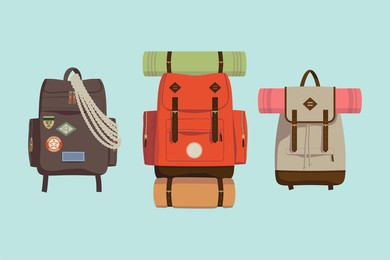The size of a standard backpack can vary, depending on the type of bag and its intended purpose. For instance, a traditional laptop bag is typically around 16 inches wide, 12 inches high, and 4 inches deep.
Most bags are designed with adjustable shoulder straps and waistbands that allow you to customize your fit for maximum comfort. There are also many different backpack styles, each with its own specific dimensions.
The everyday common backpack is generally sized at around 22 x 14 x 9 inches (55.9 x 35.6 x 22.9 centimeters). These backpacks are convenient for carrying a variety of items, with capacities ranging from 15 to 35 liters. This translates to approximately 4 to 9.2 gallons, providing plenty of room for supplies. Although, the size of a backpack can vary depending on its design and the number of items it holds.
In this post below, I will discuss different types of backpacks and their dimensions, as well as other important considerations when selecting a backpack.
Types of Backpacks by Uses
There are many different types of backpacks that are designed for specific uses. Here are a few examples:

Daypack:
They are essential for carrying a large number of items on the go. They usually come with soft padding and internal compartments to store larger items such as laptops, textbooks, and other stationery. Generally, they can hold up to 15-35 liters (4-9.2 gallons) of items. The typical dimensions of a standard everyday backpack are 22 inches in length, 14 inches in width, and 9 inches in height.
Hiking backpack:
A larger backpack that is specifically designed for carrying gear on extended hikes or backpacking trips. These backpacks often have a frame and multiple pockets for organizing gear, as well as features like a hydration bladder for carrying water. They come in a variety of sizes and can generally hold between 20 to 60 liters (5.3 to 15.9 gallons) of supplies. Some bags can even hold more than 60 liters, allowing for more space for additional gear. The size of a hiking bag can vary significantly, ranging from 17 x 8 x 5 inches (43.2 x 20.3 x 12.7 cm) up to 30 x 18.5 x 12.5 inches (76.2 x 47 x 31.8 cm) when empty.
School backpack:
A backpack that is used to carry books and other supplies for school or work. These backpacks are usually medium to large in size and may have features like padded shoulder straps and laptop sleeves. Most school backpacks range in size from about 17 to 35 liters, with the most common size being around 25 liters. They have a rectangular shape with dimensions of around 11-13 inches in width, 16-20 inches in height, and 6-10 inches in depth.
Travel backpack:
A backpack designed for carrying gear while traveling. These backpacks are often larger in size and may have features like lockable zippers and RFID-blocking technology to help keep belongings secure. Most travel backpacks range in size from about 30 liters (small) to 90 liters (large), with the most common size being around 50 liters. They have a rectangular shape with dimensions of around 11-13 inches in width, 18-22 inches in height, and 8-12 inches in depth.
Baby backpack:
A backpack designed for carrying gear and supplies for a baby or young child. These backpacks often have features like padded shoulder straps and a built-in changing pad. Most baby backpacks range in size from about 20 liters (small) to 35 liters (large), with the most common size being around 25 liters. In terms of dimensions, they generally have a rectangular shape with dimensions of around 10-12 inches in width, 14-18 inches in height, and 6-8 inches in depth.
Camera backpack:
A backpack designed specifically for carrying camera gear. These backpacks often have padded compartments for protecting equipment and may also have additional pockets for storing accessories. Most camera backpacks range in size from about 20 liters (small) to 50 liters (large), with the most common size being around 30-40 liters. The camera backpacks generally have a rectangular shape with dimensions of around 11-13 inches in width, 16-20 inches in height, and 6-10 inches in depth.
Hydration backpacks:
Hydration backpacks are a type of outdoor bag designed specifically for carrying liquids. They are easily identifiable by their pouch or bladder, which helps to keep liquids safe and secure while on the go. Hydration backpacks come in a variety of sizes, ranging from those with a capacity of 7 liters to those that can carry up to 20 liters. The dimensions of an empty small-sized hydration backpack are approximately 11 inches by 10 inches by 4 inches (27.9 cm x 25.4 cm x 10.2 cm).
Related: What Are Graduation Cap Dimensions?
Types of Backpacks by Capacity

Backpacks are often classified by their capacity, which refers to the amount of gear that the backpack can hold. Here are a few examples of backpacks based on capacity:
Ultralight backpacks:
These are small backpacks with a capacity of around 20 liters or less. They are designed for carrying only a few essentials and are ideal for short trips or activities where you don’t need to carry much gear. For 4-7 day backcountry trips, 50 liters (3050 cu in) is a great and standard size for an ultralight pack.
Daypack:
Daypacks have a capacity of around 20-35 liters and are ideal for carrying a few essentials for a short trip, such as a water bottle, snacks, and a jacket. The typical dimensions of a standard everyday backpack are 22 inches in length, 14 inches in width, and 9 inches in height.
Multiday backpacks
Multiday backpacks are specially designed for long-distance hikes and camping trips. These large-capacity bags can hold up to 50 to 80 liters (13.2 to 21.1 gallons) of supplies, making them ideal for carrying the necessary items for extended periods outdoors. If you’re looking for a backpack suitable for an outdoor trip that lasts up to five nights, then a 65-liter backpack should be your top choice. This type of backpack typically measures 27 inches in length, 16 inches in width, and 9 inches in depth (68.6 cm x 40.6 cm x 22.9 cm).
Weekend backpack:
These backpacks have a capacity of around 35-50 liters and are suitable for carrying gear for a weekend trip or longer excursion. The 40-liter weekend backpack is the most common among all so it typically measures 21 inches in height, 11 inches in width, and 8 inches in depth.
Expedition backpack:
These are large backpacks with a capacity of 90 liters or more. They are designed for carrying all of your gear for extended backpacking or mountaineering trips. A 100-liter bag is the standard size which typically measures 18 × 13 × 9 inches (45.7 × 33 × 22.9 cm). It usually has various compartments located on the sides and near the bottom. This makes it an ideal storage solution for transporting items of different sizes.
Related: Comic Book Dimensions
Standard Backpack Dimensions
The following table provides a helpful reference for understanding backpack sizes based on their type. It can be used as a guide when selecting the right size of bag for your needs.
| Backpack Types | Dimensions (H × W × D) inches | �Capacity |
|
|---|---|---|---|
| By Uses | Daypack | 22 x 14 x 9 inches | 15-35 liters (4-9.2 gallons) |
| Hiking backpack | 17 x 8 x 5 to 30 x 18.5 x 12.5 | 20 to 60 liters (5.3 to 15.9 gallons) | |
| School backpack | 16 x 11 x 6 to 20 x 13 x 10 | 17 to 35 liters | |
| Travel backpack | 18 x 11 x 8 to 22 x 13 x 12 | 30 liters (small) to 90 liters (large) | |
| Camera backpack | 16 x 11 x 6 to 20 x 13 x 10 | 20 liters (small) to 50 liters (large) | |
| Hydration backpacks | 11 x 10 x 4 | 7 to 20 liters | |
| Backpacks by Capacity | Ultralight backpacks | 9 x 14 x 22 | 50 liters (3050 cu in) |
| Multiday backpacks | 27 x 16 x 9 | 50 to 80 liters (13.2 to 21.1 gallons) | |
| Weekend backpack | 21 x 11 x 8 | 35-50 liters | |
| Expedition backpack | 18 × 13 × 9 | 90 liters or more | |
Available Features in Backpacks
There are many different features that can be found on backpacks, and the specific features available will depend on the type and style of the backpack. Here are a few common features that you may find on backpacks:
Pockets:
Many backpacks have multiple pockets for organizing and storing gear. These can include internal pockets, external pockets, and pockets specifically designed for holding items like water bottles or laptops.
Shoulder straps:
Padded shoulder straps for carrying the backpack comfortably on your back. Some backpacks also have chest or hip straps to help distribute the weight of the backpack more evenly.
Laptop sleeves:
Many backpacks designed for school or work have a dedicated compartment or sleeve for holding a laptop. These sleeves are often padded to protect the laptop from damage.
Rain cover:
Most of the backpacks now come with a rain cover that can be used to protect the backpack and its contents from wet weather.
Hydration bladder:
Particularly those designed for hiking or backpacking, have a built-in hydration bladder or a compartment for carrying a hydration bladder. This allows you to carry water with you and easily access it while on the go.
External attachment points:
Some backpacks have external attachment points that allow you to attach additional gear, such as a sleeping pad or tent, to the outside of the backpack.
Lockable zippers:
Lockable zippers are very important if you have more public interactions. Backpacks have lockable zippers to help secure the contents of the backpack and prevent theft.
RFID blocking technology:
Some backpacks have RFID-blocking technology to help protect against identity theft by blocking RFID signals.
Reflective elements:
Reflective elements are one of the main features nowadays and especially in winter, such as reflective strips or logos, to help make the backpack more visible in low light conditions.
Conclusion:
So in this post, I have discussed the size and dimensions of all types of backpacks in detail, along with the features that are available in them. I also have mentioned some important features of backpacks that you can consider before any of them for yourself. If you have any further questions or suggestions do not hesitate to comment or contact us.